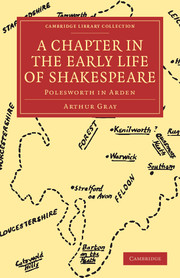Book contents
- Frontmatter
- Contents
- ILLUSTRATIONS
- SECTION 1 The Problem stated
- SECTION 2 The Marlowe fiction
- SECTION 3 The Greenwood theory
- SECTION 4 The Stratford legend
- SECTION 5 Does Shakespeare rail?
- SECTION 6 William Shakespeare, gentleman
- SECTION 7 Concerning Genius
- SECTION 8 Stratford fact and fable
- SECTION 9 The flight to London
- SECTION 10 Shakespeare's silence about Stratford
- SECTION 11 Concerning Arden
- SECTION 12 Of Poets, Patrons and Pages
- SECTION 13 What happened in 1572
- SECTION 14 Polesworth
- SECTION 15 Shakespeare in North Warwickshire
- SECTION 16 Shakespeare's road to London
- SECTION 17 Michael Drayton
- SECTION 18 The Polesworth circle
- SECTION 19 The Gooderes
- SECTION 20 The Sonnets
- SECTION 21 Southampton
- SECTION 22 Warwickshire scenes in Shakespeare's youth
- SECTION 23 The last days
- Plate section
SECTION 22 - Warwickshire scenes in Shakespeare's youth
Published online by Cambridge University Press: 07 September 2010
- Frontmatter
- Contents
- ILLUSTRATIONS
- SECTION 1 The Problem stated
- SECTION 2 The Marlowe fiction
- SECTION 3 The Greenwood theory
- SECTION 4 The Stratford legend
- SECTION 5 Does Shakespeare rail?
- SECTION 6 William Shakespeare, gentleman
- SECTION 7 Concerning Genius
- SECTION 8 Stratford fact and fable
- SECTION 9 The flight to London
- SECTION 10 Shakespeare's silence about Stratford
- SECTION 11 Concerning Arden
- SECTION 12 Of Poets, Patrons and Pages
- SECTION 13 What happened in 1572
- SECTION 14 Polesworth
- SECTION 15 Shakespeare in North Warwickshire
- SECTION 16 Shakespeare's road to London
- SECTION 17 Michael Drayton
- SECTION 18 The Polesworth circle
- SECTION 19 The Gooderes
- SECTION 20 The Sonnets
- SECTION 21 Southampton
- SECTION 22 Warwickshire scenes in Shakespeare's youth
- SECTION 23 The last days
- Plate section
Summary
I have said, and I am firmly convinced, that in his Plays Shakespeare never consciously delineated the individual features or characteristics of any contemporary. Shallow is the composite portrait of many Shallows known to him. I am equally convinced that, excepting places in or near London and Windsor, which were as familiar to his audiences as to himself, he is never at any pains to picture the actual localities in which his scenes are laid. When Edgar describes Dover cliffs he is really out of hearing of the sea and standing on even ground. Shakespeare's stage had no scenery to explain to the audience that the scene of the Merchant was laid in Venice, and he gives no description of its water-ways to help them to realise that Venice was other in appearance than Ephesus or an un-named city in Illyria. So far let Stratford take comfort. If Shakespeare had chosen to lay any of his scenes in Stratford, he would have left his audience to entertain their unaided conjecture of its streets and buildings. But somehow he would have created the atmosphere of a small provincial town, as in his Venice he has created the atmosphere of merchant life and civic dignity. Somehow names of localities in the neighbourhood would have crept into his story, and he would have worked in details of his own observation of life in a petty town—small tradesmen and their wives, prentices and municipal dignitaries, such people as delighted Heywood and Middleton.
- Type
- Chapter
- Information
- A Chapter in the Early Life of ShakespearePolesworth in Arden, pp. 107 - 118Publisher: Cambridge University PressPrint publication year: 2009First published in: 1926



